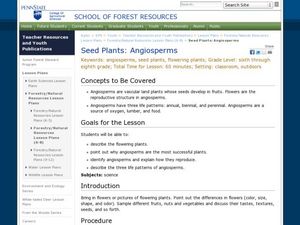Scholastic
Study Jams! Angiosperms: Seeds in Fruit
Flowers are lovely, but they are also very practical if you are a plant! In this video, kids learn that without a flower, there would be no seeds. They also find out about the two types of seeds: monocots and dicots. Pollination and...
Curated OER
Seed Plants: Angiosperms
Students describe flowering plants and see why angiosperms are the most successful plants. In this angiosperms lesson students identify angiosperms and explain how they reproduce.
Scholastic
Study Jams! Plants with Seeds
Are your blooms doomed? Not if you plant your seeds in the proper condition! Cartoon character teenagers explore seed-bearing plants, germination, and seed dispersal. They compare gymnosperms with cones, angiosperms with flowers. They...
Curated OER
Kingdom Plantae
There are some great diagrams and labels on these slides that support the topic of plants. The definition of kingdoms, and summaries of the vascular systems and gamete production are given. This would be a perfect choice to kick off a...
Curated OER
AP: Chapter 29 and 30: Plant Diversity
It's a jungle out there! That is because of the tremendous diversity among plants. In this AP biology assignment, botanists answer questions about plant evolution, diversity, and reproduction. They differentiate between monocots and...
Garden Earth Naturalist Club
Parts of a Flower! Flower Dissection
Sometimes the best way to learn about plants is to see the different parts of a plant yourself. Groups of learners dissect flowers to answer questions about what they observe and what they wonder about their flower.
Curated OER
Introduction To Plants
In this science worksheet, middle schoolers complete a series of puzzles related to the subject of plants. They complete a reading and apply the information to measure reading comprehension.
New South Wales Department of Education
Plant Groups
Bryophytes can grow in temperatures just above zero degrees. This 17th installment in a series of 20 introduces learners to the five groups of plants: algae, bryophytes, pteridophytes, gymnosperms, and angiosperms. Classes then explore...
Curated OER
The Angiosperms
Students study angiosperms and their classifications. For this investigative lesson students compare the sexual reproduction of angiosperms and seed formations.
Scholastic
Study Jams! Gymnosperms: Seeds in Cones
Two very hip teenagers walk through the forest collecting evergreen cones. One teaches the other about gymnosperms: cycads, ginkoes, gnetophytes, and conifers. He tries to convince his friend how amazing cones are, while she defends...
Curated OER
Feed Me, Seymour
Students work in small groups to create posters illustrating the major facts and functions of plant organs. Within their groups, they assume the role of specialists creating specialized posters pertaining to the different parts of plants.
Curated OER
How Do Flowering Plants Reproduce
Students investigate how flowering plants reproduce. They identify and describe the functions of the major sexual organs of a flower and fruit by examining and dissecting flowers and fruit.
Curated OER
Evolution of Plants
This is a wonderful PowerPoint! It gives excellent details of different types of ferns and their characteristics which help them to survive and produce spores in many varied habitats.
Curated OER
Collecting and Classifying Pollen
Students collect and analyze pollen from different species of plants. In small groups, they classify pollen according to shape, size and physical characteristics. They draw the basic anatomy of flowering plants and create a dichotomous...
Curated OER
What Parts of a Plant Do We Eat?
Did you know that tomtoes and cucumbers are actually fruits? Biology or botany beginners read about the function of flowers and fruit and find that some food items commonly called vegetables are, by definition, also fruits! Give learners...
Curated OER
Plant Pollution
Learners study the different parts of a flower and their functions. For this pollination lesson students study a flower under a microscope.
Curated OER
Seed Germination
Young scholars germinate a Mung Bean seed. In this seed lesson students conduct an experiment germinating a Mung Bean. They apply three different treatments to the seeds: dry, moist, and underwater incubation.
Science 4 Inquiry
Plant Structures Lab Stations
In China, hibiscus is known as the shoe flower because it is used to polish shoes, while in Hawaii, it is honored as the state flower. Young scientists learn about the structure and function of flowers. They dissect hibiscus flowers,...
Curated OER
Examining Seeds
Young scholars explore botany by conducting an investigation in class. In this seeds lesson, students utilize lima bean seeds and magnifying glasses to examine the different parts of a seed after it has been dissected. Young scholars...
Curated OER
Seed Plants: Gymnosperms
Students identify what makes up a seed. In this gymnosperms lesson students identify conifers and explain how they reproduce and what the importance of gymnosperms are.
Curated OER
Plant Phylogeny
Students examine live potted plants and create a hypothesis regarding their relationships in this upper-level introductory lesson on phylogenetic reconstruction using morphological characters. The lesson can be accomplished in...
Curated OER
Flowers and Their Life Cycles
First-time florists will be able to label the structures of simple and composite flowers after reading this handout and answering the comprehension questions. There are a couple of grammatical errors in the text, but the content is...
Curated OER
Seed Diversity
Learners explore agriculture by researching different seeds. In this seed identification lesson plan, students collaborate in small groups to analyze a package of different seeds. Learners utilize a magnifying glass to examine each seed...
Curated OER
Seed Structure and Seed Dispersal
Third graders plant seeds. In this seed structure lesson, 3rd graders identify parts of a seed and plant a lima bean seed. Students discuss and reflect on the process in their journals.























